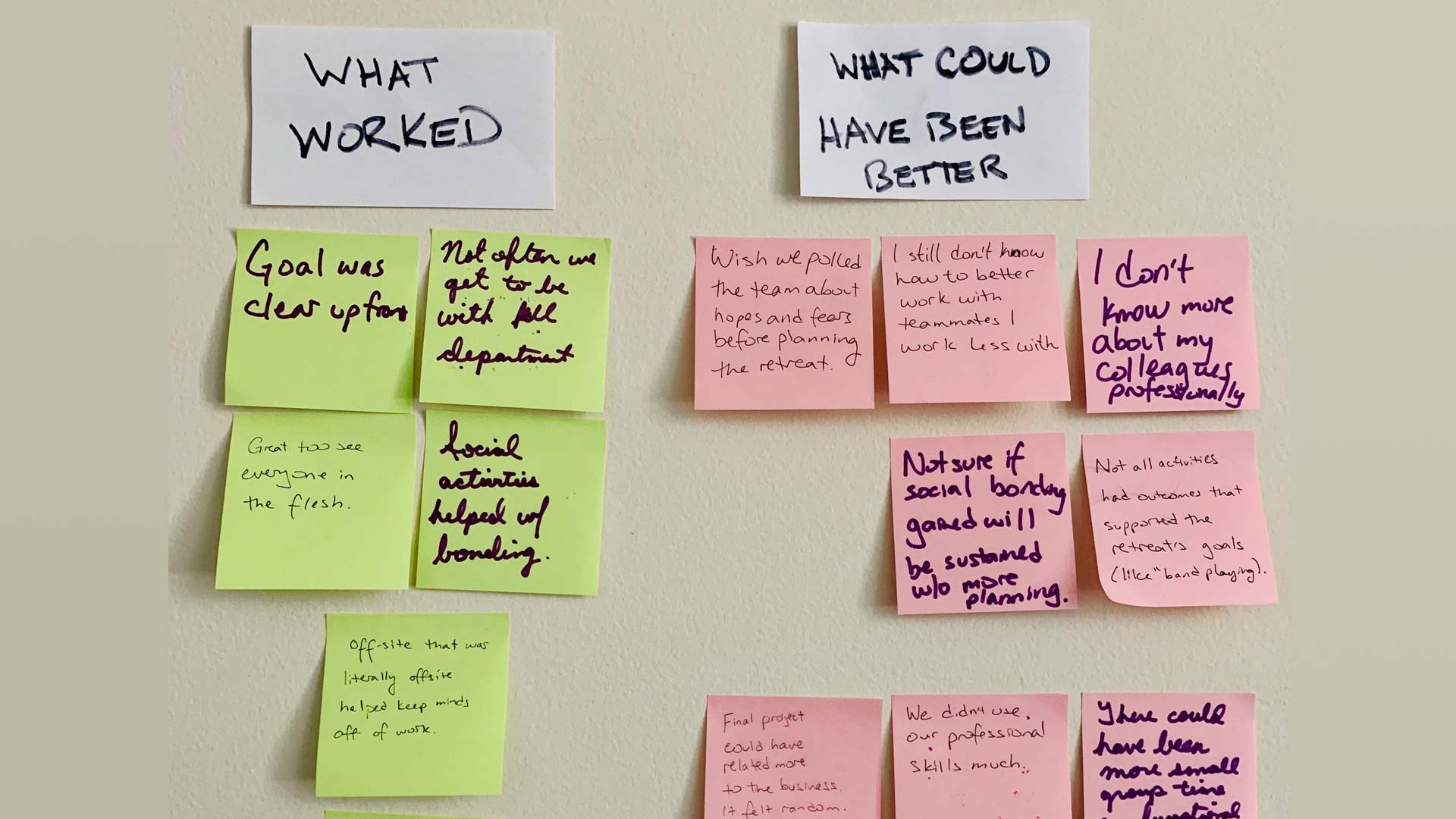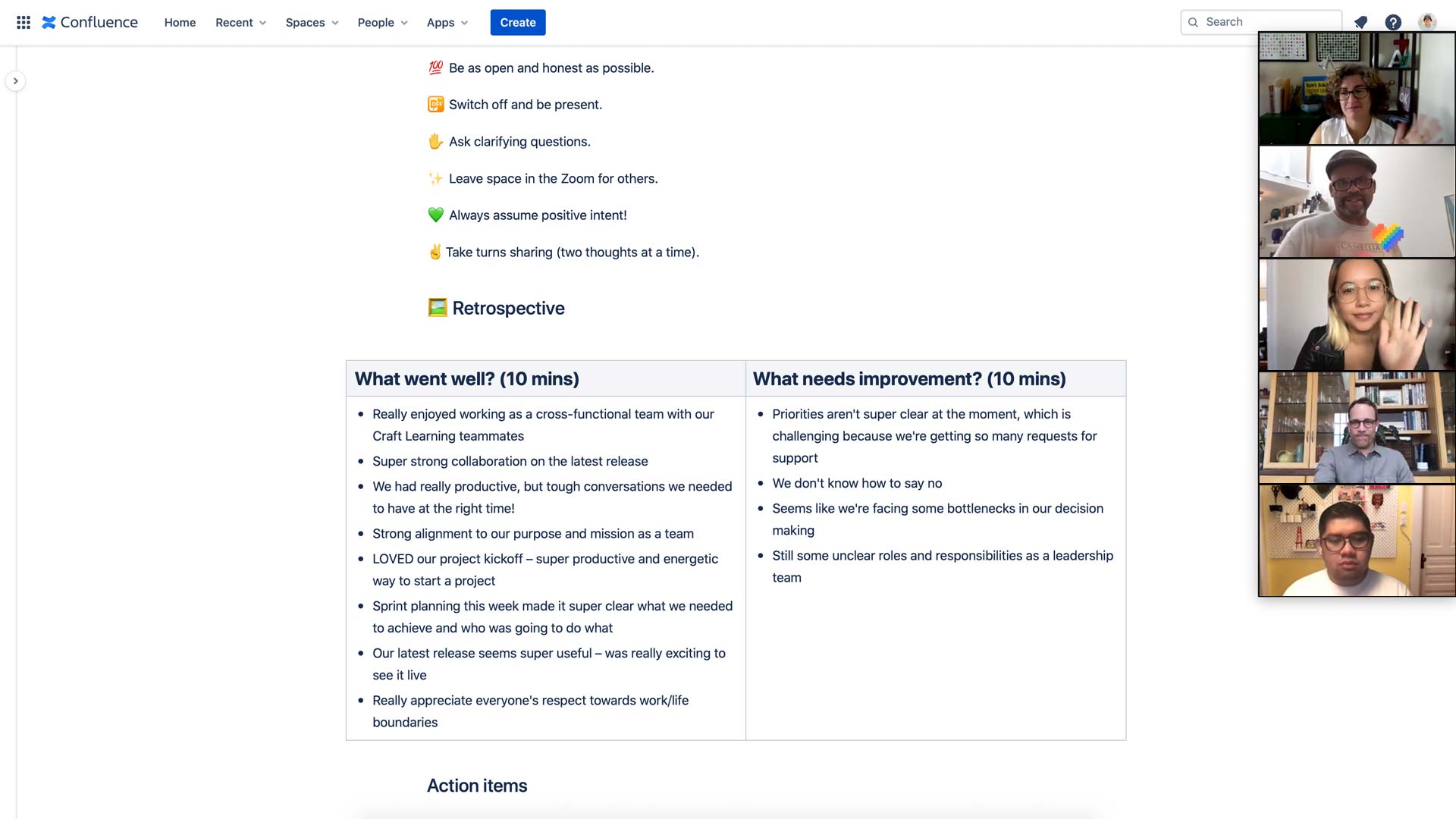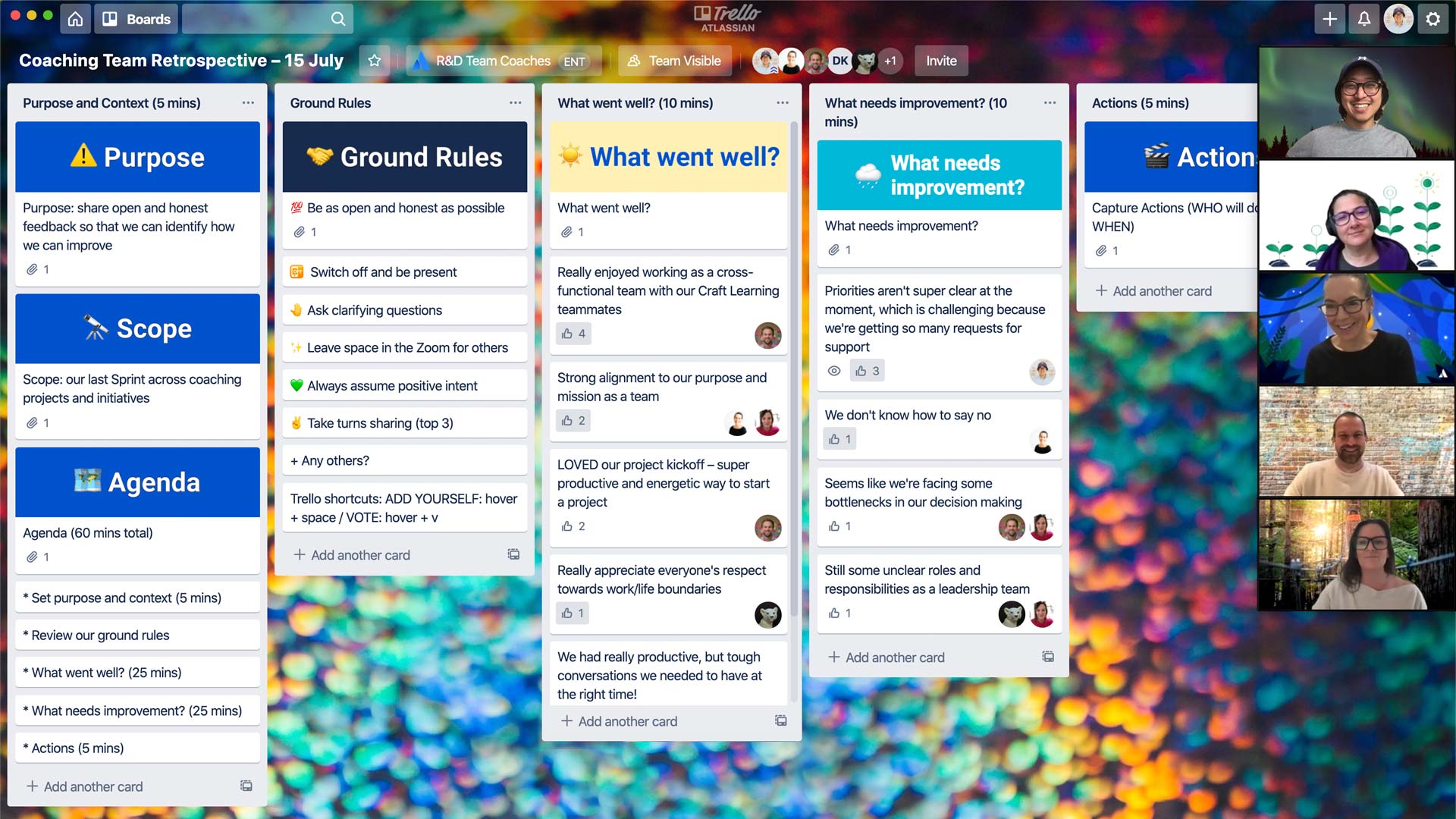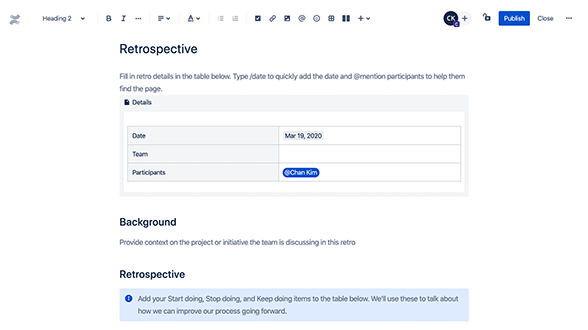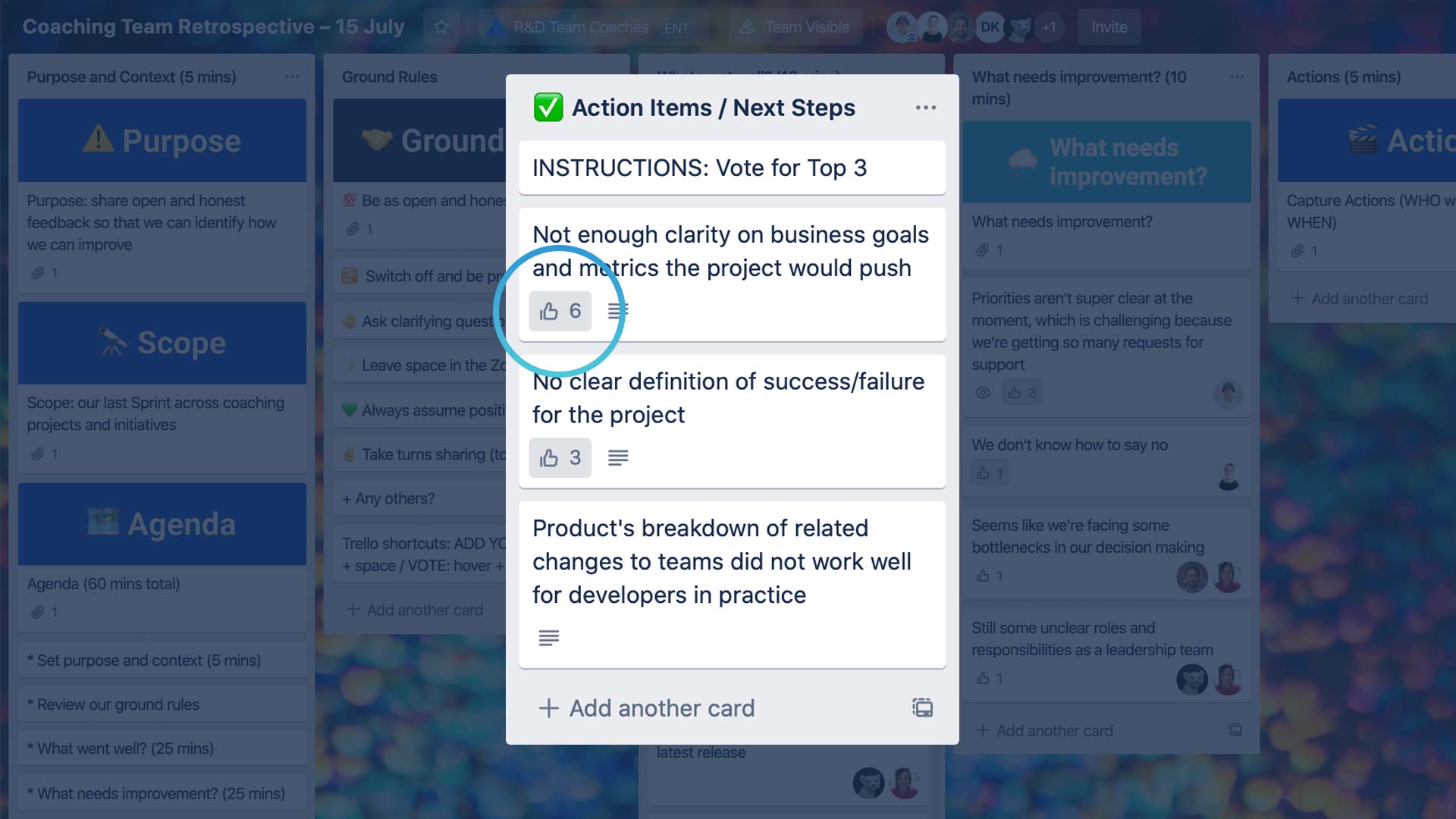Retrospettive degli sprint
Una retrospettiva dello sprint ti offre l'opportunità di rivedere il tuo ultimo sprint e apportare eventuali miglioramenti per gli sprint futuri. Questi incontri sono fondamentali perché valutare e migliorare costantemente i processi porta risultati di qualità e riduce gli ostacoli.
In questa guida, ti spiegheremo cos'è una retrospettiva dello sprint, perché è importante e come fare per condurre revisioni degli sprint di successo e rendere il tuo team più efficace.
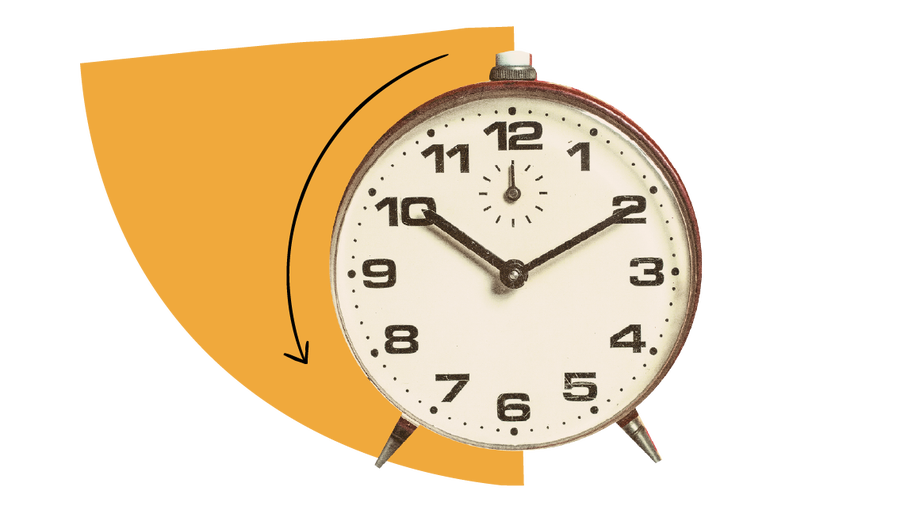
Tempo di preparazione
15 m
TEMPO di esecuzione
60 m
Persone
4-8
RIEPILOGO DI 5 SECONDI
- Celebra i successi dell'ultimo sprint.
- Parla di cosa non è andato bene o cosa si poteva fare meglio.
- Stabilisci come apportare miglioramenti nello sprint successivo.
- Usa l'IA per riassumere le informazioni, generare i punti salienti e semplificarne l'azione.
DI COSA AVRAI BISOGNO
- Uno spazio per le riunioni o videoconferenze con condivisione della schermata.
- Strumento di collaborazione digitale (vedi i modelli).
- Opzionale: lavagna fisica, pennarelli, note adesive e timer.
Come mettere in atto una retrospettiva dello sprint
Rifletti sugli sprint passati per apportare miglioramenti per il futuro.
Che cos'è una retrospettiva dello sprint?
Una retrospettiva dello sprint è una revisione condotta dopo uno sprint che svolge un ruolo chiave nella metodologia Agile. Nello specifico, mira a determinare cosa è andato bene e dove si sono verificati problemi e a identificare le aree in cui è possibile migliorare.
Le revisioni periodiche sono una parte essenziale della collaborazione in team. Comprendendo cosa funziona e cosa no, puoi migliorare i processi Agile e semplificare il tuo prossimo sprint.
E con l'IA che ti aiuta a trovare la documentazione dello sprint, a riassumere i punti salienti e a generare passaggi attuabili, le retrospettive dello sprint sono ancora più preziose.
Chi dovrebbe partecipare a una riunione retrospettiva dello sprint?
Una riunione di retrospettiva dello sprint dovrebbe coinvolgere l'owner di prodotto, il team Scrum, lo Scrum Master e le parti interessate e Rovo.
Durante la riunione è utile poter contare su un ventaglio di punti di vista diversi. I partecipanti possono collaborare per analizzare il tuo ultimo sprint e decidere quali modifiche sia necessario apportare prima di passare alla fase successiva del progetto.
Con quale frequenza dovresti organizzare le retrospettive degli sprint?
Le retrospettive sono più efficaci se eseguite alla fine di ogni sprint. Tuttavia, se gli sprint sono brevi, ad esempio una settimana, potrebbe essere più utile organizzare una retrospettiva ogni due sprint.
Quanto dovrebbero durare le retrospettive degli sprint?
La durata della riunione di retrospettiva dello sprint può variare a seconda della durata dello sprint. Queste riunioni possono durare da 45 minuti a 3 ore. Concedi al team tempo e spazio sufficienti per una conversazione significativa. Prevedere un po' di tempo in più in anticipo aiuta a risparmiare tempo e a migliorare i risultati a lungo termine.
Quali sono i principali vantaggi delle retrospettive degli sprint?
Le retrospettive degli sprint aiutano a imparare dal passato e a migliorare nel futuro, portando a sprint Scrum semplificati e a un risultato finale migliore.
Dalla ricerca è emerso che le retrospettive offrono vantaggi ai team aiutandoli a:
- Raggiungere un miglioramento continuo
L'elaborazione di un piano d'azione e il follow-up nelle riunioni successive sono fondamentali per la crescita. - Migliorare la riflessività del team
La riflessività è " la misura in cui i membri del team riflettono collettivamente sugli obiettivi, sulle strategie e sui processi del team e li adattano alle circostanze attuali o previste".
I team con livelli più elevati di riflessività hanno maggiori probabilità di ottenere risultati migliori in termini di innovazione, identificazione dei problemi e opportunità, adattamento al cambiamento e implementazione di nuove idee in modo efficace.
Una maggiore riflessività è correlata agli elementi seguenti:
- Processo decisionale migliorato
- Migliore risoluzione dei problemi
- Implementazione più efficace della strategia
- Maggiore apprendimento da parte del team
- Più innovazione
-
Maggiore adattabilità al cambiamento
La ricerca rafforza il fatto che la riflessività aiuta i team a:
- Elaborare le informazioni in modo più accurato
- Ridurre gli errori e i fallimenti
- Avere un approccio più Agile e flessibile davanti al cambiamento
Idee per riunioni sulla retrospettiva sprint
Le retrospettive sprint possono sembrare travolgenti all'inizio, ma sono un concetto piuttosto semplice. Puoi utilizzare un modello di retrospettiva sprint o seguire i cinque passaggi elencati in questa guida. Se raccogli feedback e li utilizzi per generare approfondimenti e implementare modifiche, stai facendo qualcosa di giusto.
Ogni retrospettiva sprint inizia con uno sprint di successo. Jira offre diverse funzionalità chiave che possono aiutarti a organizzare sprint di successo, tra cui:
- Backlog: i backlog ti consentono di elencare tutto il lavoro relativo a un progetto o a un'iniziativa. Puoi suddividere il lavoro in singoli sprint, che di solito durano 2 settimane.
- Board: le board di Jira ti consentono di suddividere un grande progetto in parti più gestibili in modo da poter pianificare i tuoi sprint e assicurarti che i risultati vengano rilasciati più velocemente.
- Sequenze temporali: le sequenze temporali mantengono il tuo team sincronizzato con gli stakeholder, fornendo una panoramica della sequenza temporale del progetto con elementi di lavoro, dipendenze e versioni mappati.
Jira semplifica la visualizzazione, il monitoraggio e la gestione degli sprint per i team Agile. Con Jira, puoi semplificare il tuo prossimo sprint per garantire risultati tempestivi. Prova le board Scrum di Jira e scopri come Jira può aiutarti a ottimizzare il tuo team Agile.
Retrospettiva dello sprint - Domande frequenti
1. Imposta il tono
Tempo stim.: 5 MINUTI
Le retrospettive fanno parte del processo di pianificazione dello sprint. L'obiettivo è raccogliere una serie di feedback e punti di vista per migliorare processi e risultati. Usa uno dei nostri modelli predefiniti per facilitare il processo.
All'inizio della riunione, incoraggia le persone a condividere con rispetto i loro pensieri in maniera aperta e onesta durante la sessione, concentrandoti sul miglioramento anziché sul puntare il dito verso chi ha sbagliato (questa è la chiave per sviluppare la sicurezza psicologica e una cultura di inclusione.) Per aiutarti, aggiungi Loom AI alla tua riunione per prendere appunti in modo che il tuo team possa concentrarsi sulla retrospettiva stessa.
Incoraggia il tuo team a chattare con Rovo come partner di pensiero in caso di dubbi sul tono o sui messaggi di feedback.
Suggerimento: crea uno spazio sicuro
Spiega in modo chiaro come verranno utilizzate le informazioni discusse durante la retrospettiva. Rimarranno all'interno del gruppo? Saranno condivise con la leadership? Prendi in considerazione l'idea di adottare la Chatham House Rule per aiutare i membri del team a sentirsi al sicuro e a proprio agio.
2. Raccogli il feedback
Tempo stim.: 15 minuti
Dopo aver definito il tono e le aspettative della riunione, puoi raccogliere il feedback dei membri del team su come è andato l'ultimo sprint. Puoi usare diversi approcci, tra cui:
- 💬 Discussione aperta di gruppo su cosa è andato bene e cosa no
- 🗒️ Sondaggi (anonimi o con nome)
- ❤️ Retrospettiva 4L: parla di ciò che ognuno ha amato (Loved), odiato (Loathed), imparato (Learned) e desiderato (Longed) durante l'ultimo sprint
- 🙂 Il framework Felice/Triste/Arrabbiato: parla insieme al team per capire cosa ha suscitato queste emozioni. Cosa è stato deludente? Frustrante? Emozionante e incoraggiante?
- Usa Ricerca Rovo per raccogliere pagine o ticket pertinenti per contestualizzare il feedback.
Suggerimento: lascia che le persone parlino
Uno dei maggiori ostacoli a un retrospettiva dello sprint è quando i membri del team non condividono molti feedback. Oltre a creare uno spazio sicuro, prova a condurre la conversazione con una struttura semplice come le 4L o l'approccio Felice/Triste/Arrabbiato. Puoi anche provare a raccogliere feedback anonimi.
Se qualcuno sta dominando la conversazione, chiedi agli altri di esprimere il loro pensiero per assicurarti che tutti facciano sentire la propria voce.
3. Trasforma il feedback in approfondimenti
Tempo stim.: 20 minuti
Come gruppo, cerca modelli e tendenze nel feedback. Cosa abbiamo imparato? Cosa potremmo cambiare per sfruttare ciò che è andato bene e minimizzare o evitare ciò che è andato male? Questi approfondimenti sono fondamentali per definire gli obiettivi e migliorare, quindi incoraggia tutti a fornire il proprio contributo.
Suggerimento: osserva le tendenze
Le retrospettive degli sprint servono a migliorare lo sprint successivo, quindi concentrati di più su modelli e tendenze rispetto a errori o successi occasionali che molto probabilmente non si ripeteranno più.
Suggerimento: includi Rovo nel gruppo
Usa Rovo Chat per sintetizzare il feedback in modelli e tendenze chiave.
4. Crea elementi di azione
Tempo stim.: 15 minuti
Ora è il momento di trasformare gli approfondimenti in azione. È a questo punto che puoi iniziare a definire gli obiettivi e a determinare le modifiche da apportare per gli sprint futuri.
Man mano che documenti le modifiche e gli elementi di azione, assicurati di assegnare proprietari e scadenze per dare il via all'avanzamento.
Suggerimento: aggiungi elementi di azione all'elenco di attività
Invece di (o in aggiunta a) scrivere elementi di azione su una nota adesiva o su un documento digitale, inseriscili direttamente nella pianificazione dello sprint o nel sistema di gestione dei progetti, come Jira o Trello, in modo che siano già incorporati nei piani.
Se a un elemento di azione sono associati dei ticket di assistenza o dei ticket, includi i link nelle pagina e/o nelle attività della retrospettiva in modo che sia facile vedere lo stato.
Suggerimento: usa AI Chat
Converti feedback, schemi e approfondimenti in passaggi successivi attuabili con AI Chat.
5. Conclusione
Tempo stim.: 5 MINUTI
Concludi la retrospettiva dello sprint ringraziando tutti per i loro contributi e condividendo un riepilogo delle informazioni chiave e degli elementi di azione. Poi passa allo sprint successivo.
Varianti
Fai in modo che le retrospettive siano vivaci, fai una cernita e sbarazzati degli esercizi che non servono a nulla. Esistono vari modi per incoraggiare la conversazione, quindi fai diverse prove per scoprire qual è il più adatto per il tuo gruppo. Ecco nove dei nostri esercizi di retrospettiva dello sprint preferiti.

Hai altre domande?
Inizia una conversazione con altri utenti del Playbook dei team Atlassian, richiedi assistenza o fornisci il feedback.
Altre strategie che potrebbero piacerti
Riunioni
Aggiornamenti settimanali sul team
Condividi come vanno le cose, senza fissare un'altra riunione.
Riunioni
Riunioni dirette da una pagina
Delle riunioni migliori iniziano con una pagina che illustra lo scopo, i risultati previsti e i punti chiave da discutere.
Comunicazione
Manuale utente
Aiuta i membri del tuo team a capire come lavorare al meglio con te.
Cultura
Controllo salute del team
Valuta lo stato di salute del tuo team e stabilisci un piano di miglioramento.
Tieniti aggiornato
Ricevi gli ultimi consigli sulle Strategie e sulla vita lavorativa iscrivendoti alla nostra newsletter.







